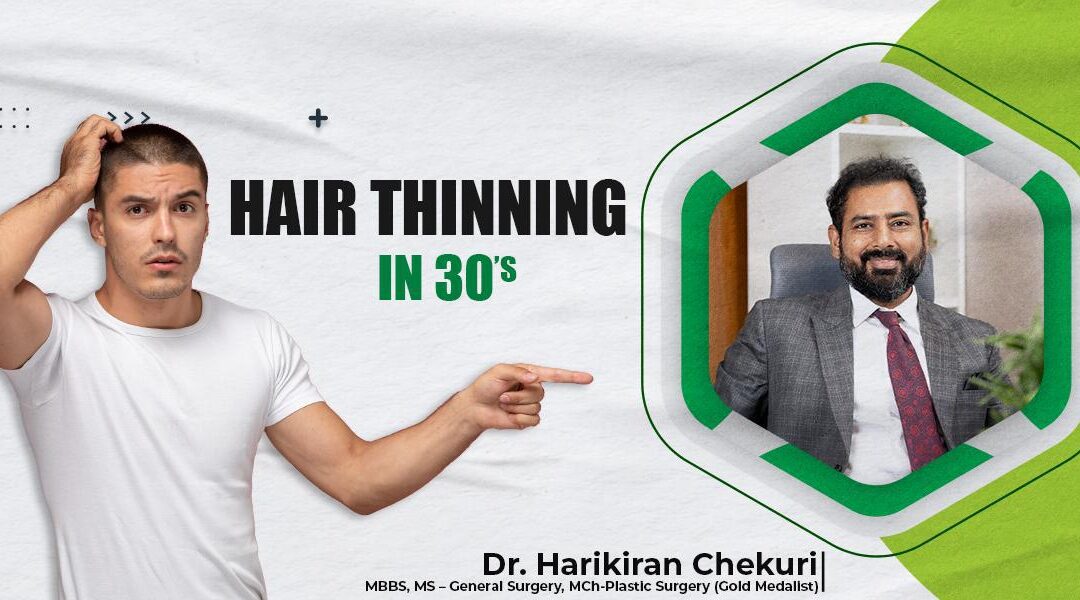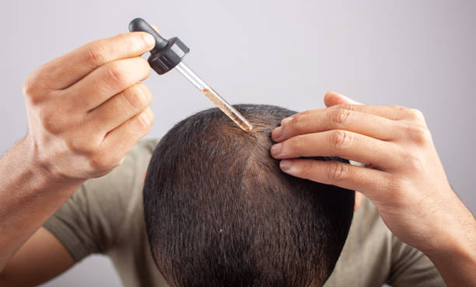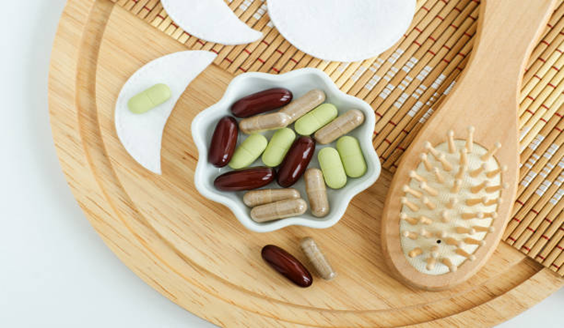Hair thinning, also known as alopecia or hair loss, is a common condition that affects men and women. It is characterized by a gradual reduction in hair density and thickness. Hair thinning in 30s can be particularly distressing. However, it’s essential to address it early. Seek guidance from a qualified dermatologist or a plastic surgeon specializing in hair restoration. They can help you understand the cause and explore treatment options.
At Redefine Clinic, Dr. Harikiran Chekuri, an acclaimed plastic surgeon in Hyderabad, has a deep understanding of the complexities of hair thinning. He conducts a thorough evaluation to identify the root causes of hair thinning. Based on diagnosis, he offers customized, effective hair restoration solutions.
Widely recognized for his expertise in hair transplant in Hyderabad, Dr. Harikiran Chekuri is dedicated to delivering natural-looking results that surpass expectations. He ensures you feel heard, understood, and empowered throughout your journey to achieving fuller, thicker hair.
Now, let’s explore if it’s common to have hair thinning in 30s.
Is it Normal to Have Thinning Hair in 30s?
Experiencing hair thinning in 30s is a common occurrence. It affects a significant portion of the population. Research suggests that around 30% of individuals notice signs of hair loss in their 30s.
Seeking early intervention can help slow down or reverse the process. Effective treatments are available for both males and females losing hair in 30s. If you’re concerned about thinning hair, consult a hair specialist. They can provide effective treatments tailored to your needs.
Don’t let hair thinning dampen your confidence. Reach out for expert advice today!
Understanding the root causes of thinning hair in 30s is essential. Let’s uncover the factors contributing to this issue.
What Causes Hair Thinning in 30s?

- Hormonal Changes:
Fluctuations in hormones, particularly androgens, can contribute to hair thinning in 30s.
- Genetic Predisposition:
Family history plays a significant role, with inherited genes often determining the pattern and timing of hair loss.
- Stress:
Work, relationships, and lifestyle pressures can increase stress levels, triggering hair thinning.
- Poor Nutrition:
Inadequate intake of essential nutrients, such as iron, protein, and vitamins, can compromise hair health.
- Environmental Factors:
Exposure to pollutants, UV radiation, and harsh chemicals can damage the hair follicles, leading to thinning.
- Medical Conditions:
Certain health conditions like thyroid disorders and autoimmune diseases can also contribute to hair thinning.
- Hairstyling Practices:
Excessive heat styling, tight hairstyles, and chemical treatments can weaken the hair shaft, causing it to become thin and brittle.
- Medications:
Some medications, including those for chronic illnesses, may have hair thinning as a side effect.
- Aging:
As we age, hair follicles may shrink and become less active, resulting in thinner hair growth.
- Poor Scalp Health:
Conditions like dandruff, scalp infections, and poor circulation can hinder healthy hair growth, leading to thinning.
Hair Thinning in 30s Male Vs Female

Hair thinning can affect both men and women in their 30s. However, there are some key differences between the two:
- Hormonal Differences:
- Male: Testosterone levels start declining, leading to hair follicle shrinkage.
- Female: Fluctuating hormone levels, especially during pregnancy or menopause, can trigger hair thinning.
- Pattern of Hair Loss:
- Male: Typically starts with a receding hairline or thinning at the crown.
- Female: Often results in overall thinning, especially at the part line.
- Genetics:
- Male: Male pattern baldness, or androgenetic alopecia, is commonly inherited from either parent.
- Female: Female-pattern hair loss can also be genetic. However, it may manifest differently from hair thinning in 30s male.
- Lifestyle Factors:
- Male: Factors like smoking, excessive alcohol consumption, and poor diet can exacerbate hair thinning.
- Female: Stress, nutritional deficiencies, and hormonal imbalances are significant factors for thinning hair in 30s female.
- Treatments:
- Male: Common options include medications like finasteride, topical treatments like minoxidil and, in severe cases, hair transplantation.
- Female: Topical treatments, PRP therapy, hormonal therapy, and lifestyle modifications are often recommended. However, female hair transplants are also available.
“With proper diagnosis and treatment, men and women can effectively manage hair thinning and prevent further loss. However, individual responses to treatment can vary,” explains Dr. Harikiran Chekuri.
Treatment Options
- Medications:
Prescription medications like minoxidil (Rogaine) or finasteride (Propecia) can help slow down hair loss and stimulate new hair growth. They’re typically used in combination for best results.
- Nutritional Supplements:
Certain vitamins and minerals, like biotin, vitamin D, and iron, are crucial in maintaining healthy hair. Supplements can help fill any nutritional gaps and support overall hair health.
It involves extracting a small amount of the patient’s blood and processing it to isolate platelet-rich plasma. The doctor then injects this concentrated plasma into the scalp for hair restoration. It’s a safe and effective non-surgical option that can improve hair thickness and density.
- Low-Level Laser Therapy (LLLT):
LLLT utilizes red light therapy to stimulate hair follicles and encourage hair growth. It is a painless and non-invasive option for hair restoration.
- Hair Transplant Surgery:
For more advanced cases of hair thinning, hair transplant surgery can be a highly effective option. It involves moving hair follicles from areas of dense hair growth to thinning or balding areas. Modern techniques like follicular unit extraction (FUE) or Bio FUE ensure natural-looking results with minimal scarring.
Are you concerned about hair transplant cost in Hyderabad? Rest assured; we offer transparent pricing and customizable treatment plans to suit your budget and needs. Click here for the detailed cost breakdown.
The effectiveness of each treatment varies from person to person, depending on the cause and severity of hair thinning. So, it’s essential to consult a qualified hair doctor to determine the best treatment for your needs.
Don’t wait any longer to address hair thinning. Get in touch for personalized guidance.
Prevention is key. Let’s explore the steps to maintain healthy hair.
How to Prevent Hair Thinning in 30s?
- Maintain a Balanced Diet:
- Ensure your diet contains essential nutrients like protein, iron, vitamins, and minerals.
- Incorporate foods like fish, nuts, eggs, leafy greens, and fruits to promote hair health.
- Practice Stress Management:
- High stress levels can contribute to hair thinning.
- Find activities that help you relax, such as Yoga, meditation, or hobbies.
- Avoid Harsh Hair Treatments:
- Limit the use of hot styling tools, harsh chemicals, and tight hairstyles. These can damage your hair follicles.
- Prioritize Scalp Health:
- Keep your scalp clean by washing regularly with a mild shampoo and suitable conditioner.
- Use scalp treatments or massage techniques to improve circulation and promote hair growth.
- Protect Your Hair from Environmental Damage:
- Shield your hair from sun exposure, pollution, and harsh weather conditions.
- Wear hats or
- protective clothing.
- Stay Hydrated:
- Drink plenty of water to keep your body and hair hydrated.
- It promotes overall health and prevents dryness.
- Regular Exercise:
- Engage in regular physical activity to improve blood circulation.
- It helps nourish hair follicles and promotes healthy hair growth.
- Consult a Professional:
If you notice significant hair thinning, consult a hair expert for personalized advice and treatment options.
Take a look at how your nose might finally look after a successful recovery from rhinoplasty.
Conclusion
After learning about the causes, treatments, and preventive measures for hair thinning in 30s, it’s time to take action. Dealing with hair thinning at this age requires proactive steps and expert guidance. Consulting a qualified medical expert can make all the difference. Seek support from hair specialists like Dr. Harikiran Chekuri, a renowned name in plastic surgery and hair transplant in Hyderabad.
With personalized care and advanced treatments, you can regain thicker, fuller hair and boost your confidence. Don’t let hair thinning hold you back. Take charge of your hair health today and embrace a future with renewed confidence and vitality. Schedule consultation now!
Have questions about hair thinning? Check out our FAQs for answers to common concerns.
FAQs
1. How can I stop balding in my 30s?
You can prevent baldness by:
- maintaining a healthy lifestyle
- using gentle hair care products
- seeking medical advice for effective, tailored treatment options
2. Can hair grow back after thinning?
With the proper treatment, hair can often regrow after thinning. Treatments like minoxidil, finasteride, and hair transplants can stimulate hair regrowth and restore thickness.
3. How long does it take for hair to grow back after thinning?
The timeline for hair regrowth can vary. It depends on the individual and the underlying cause of hair thinning. With proper treatment, you may see noticeable improvements in hair density within a few months to a year.
4. Can diet affect hair thinning in 30s?
Diet can affect hair thinning in your 30s. A balanced diet rich in vitamins, minerals, and protein is essential for maintaining healthy hair growth and preventing thinning.
5. How do I know if I'm a candidate for hair transplant surgery in my 30s?
You may be a candidate for hair transplant surgery if you:
- experience significant hair thinning or balding in your 30s
- have sufficient donor hair available
Consult a qualified hair transplant surgeon to determine if this treatment is suitable for you.

















